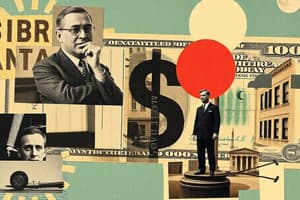Podcast
Questions and Answers
Which of the following are methods the government can use to finance its spending?
Which of the following are methods the government can use to finance its spending?
- Issuing stocks
- Levying taxes (correct)
- Increasing interest rates
- Creating money (correct)
What is the implication of financing a budget deficit through increased bond holdings by the public?
What is the implication of financing a budget deficit through increased bond holdings by the public?
- It causes a decrease in government spending.
- It leads to an increase in the monetary base.
- There is no effect on the monetary base. (correct)
- It results in higher inflation rates.
Which of the following scenarios is most likely to lead to hyperinflation?
Which of the following scenarios is most likely to lead to hyperinflation?
- Stable government spending balanced with tax revenues.
- Significant tax increases by the government.
- Excessive government money creation without corresponding economic growth. (correct)
- Sustained high bond purchases by the public.
According to Keynesian theories, what primarily influences money demand?
According to Keynesian theories, what primarily influences money demand?
How does the government budget constraint relate budget deficits to changes in the monetary base?
How does the government budget constraint relate budget deficits to changes in the monetary base?
In the context of money growth and inflation, which of the following holds true?
In the context of money growth and inflation, which of the following holds true?
What does 'monetizing the debt' refer to?
What does 'monetizing the debt' refer to?
Which situation demonstrates a weakening link between inflation and money growth?
Which situation demonstrates a weakening link between inflation and money growth?
What is the primary determinant of nominal income in the quantity theory of money?
What is the primary determinant of nominal income in the quantity theory of money?
In the long run, what assumption is made about wages and prices in the context of the quantity theory of money?
In the long run, what assumption is made about wages and prices in the context of the quantity theory of money?
How does the quantity theory of inflation express the relationship between inflation rate and economic factors?
How does the quantity theory of inflation express the relationship between inflation rate and economic factors?
Why is the quantity theory of money considered a better explanation for long-term inflation rather than short-term inflation?
Why is the quantity theory of money considered a better explanation for long-term inflation rather than short-term inflation?
What characteristic of the quantity theory of money helps explain cross-country inflation differences?
What characteristic of the quantity theory of money helps explain cross-country inflation differences?
What leads to an inflationary monetary policy according to the quantity theory of money?
What leads to an inflationary monetary policy according to the quantity theory of money?
Which of the following is a determinant of the velocity of money as proposed by Irving Fischer?
Which of the following is a determinant of the velocity of money as proposed by Irving Fischer?
In the context of liquidity preference theory, which factor is NOT one of the three motives for holding money?
In the context of liquidity preference theory, which factor is NOT one of the three motives for holding money?
If the money supply (M) increases while velocity (V) remains constant, what happens to the price level (P) according to the equation of exchange?
If the money supply (M) increases while velocity (V) remains constant, what happens to the price level (P) according to the equation of exchange?
Which statement accurately reflects a misconception about the relationship between interest rates and money demand according to Fischer's theory?
Which statement accurately reflects a misconception about the relationship between interest rates and money demand according to Fischer's theory?
What impact does using credit cards more frequently have on the demand for real money according to Fischer's quantity theory?
What impact does using credit cards more frequently have on the demand for real money according to Fischer's quantity theory?
Which of the following scenarios illustrates a situation where inflation may become hyperinflation?
Which of the following scenarios illustrates a situation where inflation may become hyperinflation?
Which element is considered part of the monetary base rather than the money supply?
Which element is considered part of the monetary base rather than the money supply?
What is the primary reason why velocity is considered reasonably constant in the short run?
What is the primary reason why velocity is considered reasonably constant in the short run?
How can an increase in the aggregate output (Y) affect the demand for money according to Fischer's theory?
How can an increase in the aggregate output (Y) affect the demand for money according to Fischer's theory?
What is the defining characteristic of hyperinflation?
What is the defining characteristic of hyperinflation?
Which of the following best describes the speculative motive for holding money?
Which of the following best describes the speculative motive for holding money?
How does Keynes's Liquidity Preference Theory classify the reasons for holding money?
How does Keynes's Liquidity Preference Theory classify the reasons for holding money?
What effect does an increase in interest rates have on the demand for real money balances according to Keynesian theory?
What effect does an increase in interest rates have on the demand for real money balances according to Keynesian theory?
Which statement accurately reflects the relationship between velocity and interest rates?
Which statement accurately reflects the relationship between velocity and interest rates?
Which of the following is NOT one of the three main motives for demand for money as outlined by Keynes?
Which of the following is NOT one of the three main motives for demand for money as outlined by Keynes?
In terms of Keynes's theories, which of the following factors can influence money demand?
In terms of Keynes's theories, which of the following factors can influence money demand?
What was one extreme example of hyperinflation mentioned?
What was one extreme example of hyperinflation mentioned?
What does the function L(i,Y) represent in the context of demand for real money?
What does the function L(i,Y) represent in the context of demand for real money?
According to Keynesian theory, how is the demand for money related to income levels?
According to Keynesian theory, how is the demand for money related to income levels?
How does the theory of portfolio choice relate the demand for real money balances to interest rates?
How does the theory of portfolio choice relate the demand for real money balances to interest rates?
Which factor decreases the demand for money according to the given factors affecting money demand?
Which factor decreases the demand for money according to the given factors affecting money demand?
What is the relationship between income and the demand for money as per Keynesian theories?
What is the relationship between income and the demand for money as per Keynesian theories?
How does wealth affect the demand for money?
How does wealth affect the demand for money?
If inflation risk rises, what is expected to happen to the demand for money?
If inflation risk rises, what is expected to happen to the demand for money?
According to the evidence, what happens to the relationship between the money supply and aggregate spending when demand for money is sensitive to interest rates?
According to the evidence, what happens to the relationship between the money supply and aggregate spending when demand for money is sensitive to interest rates?
Which of the following correctly describes a consequence of the demand for money being inelastic?
Which of the following correctly describes a consequence of the demand for money being inelastic?
What happens to money demand if there is increased risk associated with other assets?
What happens to money demand if there is increased risk associated with other assets?
Which statement regarding the classical quantity theory view on nominal income is true?
Which statement regarding the classical quantity theory view on nominal income is true?
How does the demand for money change with rising interest rates according to classical economics?
How does the demand for money change with rising interest rates according to classical economics?
Flashcards
Government Budget Constraint
Government Budget Constraint
The relationship between a government's spending, taxation, and the changes in its money supply and government bonds.
Financing Budget Deficit
Financing Budget Deficit
Ways a government can cover the difference between spending and tax revenue. It can increase taxes, borrow money by issuing bonds, or create money.
Monetizing the Debt
Monetizing the Debt
When a central bank buys government bonds to finance a budget deficit.
Budget Deficit
Budget Deficit
Signup and view all the flashcards
Public Bond Holdings
Public Bond Holdings
Signup and view all the flashcards
Money Supply
Money Supply
Signup and view all the flashcards
Inflation and Money Growth Relationship
Inflation and Money Growth Relationship
Signup and view all the flashcards
Short-run link between inflation and money growth
Short-run link between inflation and money growth
Signup and view all the flashcards
Hyperinflation
Hyperinflation
Signup and view all the flashcards
Keynesian Liquidity Preference Theory
Keynesian Liquidity Preference Theory
Signup and view all the flashcards
Transactions Motive
Transactions Motive
Signup and view all the flashcards
Precautionary Motive
Precautionary Motive
Signup and view all the flashcards
Speculative Motive
Speculative Motive
Signup and view all the flashcards
Real vs. Nominal Money Balances
Real vs. Nominal Money Balances
Signup and view all the flashcards
Velocity of Money
Velocity of Money
Signup and view all the flashcards
Velocity and Interest Rates
Velocity and Interest Rates
Signup and view all the flashcards
Payment Technology and Money Demand
Payment Technology and Money Demand
Signup and view all the flashcards
Is Velocity Constant?
Is Velocity Constant?
Signup and view all the flashcards
Keynesian Liquidity Preference
Keynesian Liquidity Preference
Signup and view all the flashcards
Portfolio Choice Theory
Portfolio Choice Theory
Signup and view all the flashcards
How does income affect money demand?
How does income affect money demand?
Signup and view all the flashcards
How do interest rates affect money demand?
How do interest rates affect money demand?
Signup and view all the flashcards
How does payment technology affect money demand?
How does payment technology affect money demand?
Signup and view all the flashcards
How does wealth affect money demand?
How does wealth affect money demand?
Signup and view all the flashcards
How does risk affect money demand?
How does risk affect money demand?
Signup and view all the flashcards
How does liquidity of other assets affect money demand?
How does liquidity of other assets affect money demand?
Signup and view all the flashcards
How does inflation affect money demand?
How does inflation affect money demand?
Signup and view all the flashcards
What is Velocity of Money?
What is Velocity of Money?
Signup and view all the flashcards
Equation of Exchange
Equation of Exchange
Signup and view all the flashcards
What determines velocity?
What determines velocity?
Signup and view all the flashcards
Demand for Money
Demand for Money
Signup and view all the flashcards
How does the quantity theory relate to money demand?
How does the quantity theory relate to money demand?
Signup and view all the flashcards
Liquidity Preference Theory
Liquidity Preference Theory
Signup and view all the flashcards
Portfolio Theory of Money Demand
Portfolio Theory of Money Demand
Signup and view all the flashcards
Quantity Theory of Money
Quantity Theory of Money
Signup and view all the flashcards
How does the Quantity Theory link to inflation?
How does the Quantity Theory link to inflation?
Signup and view all the flashcards
Why is the Quantity Theory better in the long run?
Why is the Quantity Theory better in the long run?
Signup and view all the flashcards
What makes the Quantity Theory not perfect in the short run?
What makes the Quantity Theory not perfect in the short run?
Signup and view all the flashcards
Study Notes
Chapter 20: Quantity Theory, Inflation, and the Demand for Money
- The chapter discusses quantity theory, inflation, and the demand for money
- Learning objectives include assessing the relationship between money growth and inflation, identifying circumstances where budget deficits lead to inflationary policy, summarizing the motives behind liquidity preference theory, and assessing empirical evidence of liquidity preference and portfolio theories.
Velocity of Money and Equation of Exchange
- The equation of exchange is MV = PY
- M = money supply
- V = velocity of money (average times per year a dollar is spent)
- P = price level
- Y = aggregate output (real GDP)
- PY = aggregate nominal income (nominal GDP)
- Velocity is determined by institutional and technological features of the economy, such as charge accounts and credit cards. Using credit cards more often leads to a higher velocity.
Demand for Money
- Fisher's quantity theory can be interpreted as the demand for money, or the quantity people want to hold
- If money supply equals money demand, then Md = M
- If velocity of money is constant, then k = 1/V
- Md = kPY
- Demand is purely a function of income (PY)
- Interest rates have no effect
From the Equation of Exchange to the Quantity Theory of Money
- Fisher's view that velocity is fairly constant in the short run transforms the equation of exchange into the quantity theory of money.
- Nominal income is determined solely by movements in the quantity of money (M)
Quantity Theory and the Price Level
- Classical economists believed wages and prices are completely flexible
- Aggregate output (Y) remains at the full-employment level during normal times
- Price level (P) is calculated by dividing both sides of the equation MV = PY by Y
- P = (MV)/Y
Quantity Theory and Inflation
- The quantity theory of money can be transformed into a theory of inflation
- Price level is proportional to money supply, velocity, and real GDP
- Assuming constant velocity, inflation rate (π) = %ΔM - %ΔY
Testing the Quantity Theory of Money
- The quantity theory is a good theory of inflation in the long run, but not in the short run
- Long run: based on assumption that wages and prices are flexible, growth rate of aggregate output over 10-year periods does not vary dramatically. Explains cross-country inflation differences.
- Short run: Many periods where money growth is high but inflation is low.
Budget Deficits and Inflation
- The government budget constraint: Deficit = Spending – Taxes = Change in monetary base + change in government bonds
- Ways a government pays for spending: raise taxes, issue government bonds, or create money to spend
- If the government deficit is financed by an increase in bond holdings by the public, there's no effect on the monetary base and the money supply.
- If the deficit is not financed by increased bond holdings, the monetary base and the money supply increase.
- Monetizing the debt/printing money: When the central bank purchases government bonds, this action monetizes the debt.
Hyperinflation
- Hyperinflation is extremely high inflation (over 50% per month).
- Many economies, both poor and developed, have experienced hyperinflation.
- Zimbabwe in the 2000s provides a historical example.
Keynesian Theories of Money Demand
- Keynes' Liquidity Preference Theory includes 3 Motives for holding money: transactions, precautionary, and speculative.
- Distinguishes between real and nominal quantities of money
Three Motives of Money Demand
- Transactions motive: Initially accepted the quantity theory view that the transactions component is proportional to income. Later economists recognized that payment technology can affect the demand for money.
- Precautionary motive: Keynes recognized that people hold money as a cushion against unexpected wants and that the precautionary money balances are proportional to income.
- Speculative motive: People hold money as a store of wealth.
Putting the Three Motives Together
- Be careful to distinguish between nominal and real quantities
- Suppose people hold a certain amount of real money balances (Md/P)
- Demand for real money balances falls with interest rate and rises with real income. Demand for real money and real income and velocity are related, with velocity rising with the interest rate.
- Velocity is not constant. Demand for money is negatively related to interest rates; if interest rates rise, velocity rises.
Portfolio Theories of Money Demand
- Theory of Portfolio Choice: The demand for real money balances is positively related to income and negatively related to the nominal interest rate
- Other factors affecting demand for money: Wealth, risk, and liquidity of other assets
Factors That Determine the Demand for Money (Summary Table)
- Summary table showing variables affecting money demand, direction of change in the variable, the response in money demand, and the reason for the response. Includes interest rates, income, payment technology, wealth, risk of other assets, inflation risk, and liquidity of other assets
Evidence: Interest Rates and Money Demand
- Velocity is more likely to be constant (or predictable) if interest rates do not affect the demand for money.
- The quantity theory is more likely to be true.
- The more sensitive the demand for money is to interest rates, the less clear link there is between the money supply and aggregate spending.
Evidence: Stability of Money Demand
- Unstable, unpredictable shifts in the money demand function make velocity unpredictable, and the relationship between money and aggregate spending less direct.
- Post-1973 financial innovations call into question the adequacy of theories, and raise concerns for implementing effective money policies involving money demand functions.
Studying That Suits You
Use AI to generate personalized quizzes and flashcards to suit your learning preferences.
Related Documents
Description
Dive into Chapter 20, which explores the quantity theory of money and its relationship with inflation. Understand key concepts like the equation of exchange and the demand for money. This quiz covers learning objectives related to liquidity preference theory and its empirical evidence.




